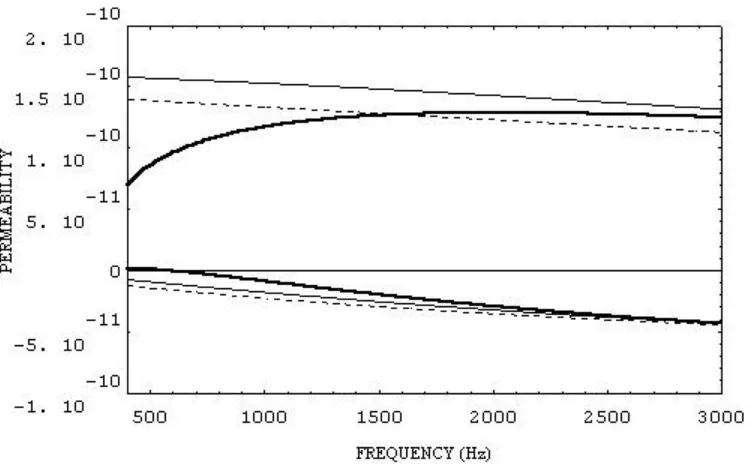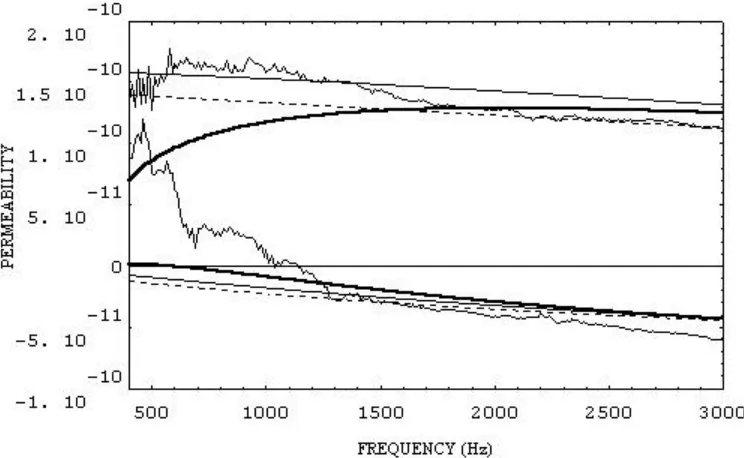ACOUSTIC PERMEABILITY FOR THE CHARACTERIZATION OF POROUS
SAMPLES
REFERENCIA PACS: 43.55.E.v
Picard López M.A);.(1); Solana Quirós P.E.(1); Arizo Serrulla J.V.(2); Moreno Esteve, J.C.(1); Martinez Rodriguez, D.(1)
Universidad Politécnica de Valencia
(1) Departamento de Física Aplicada. E.T.S. de I. Industriales
(2) Departamento de Ingeniería e Infraestructura de los Transportes. E.T.S. de I. de Caminos, Canales y Puertos Camino de Vera s/n. Apartado de Correos 22012
46022 Valencia. España
Tel: 34 963 877 524, 34 963 877 007 ext 75244 Fax: 34 963 879 529
e-mail:; mapicard@fis.upv.es, psolana@fis.upv.es;, jarizos@tra.upv.es; jcmestev@fis.upv.es: damarod@etsii.upv.es
ABSTRACT
Usually in the last years the phenomenological approach has been a way for the research in the study of the porous materials. It allows important simplifications in the theoretical models, and it depends on parameters whose static value can be determined by non-acoustic methods that affect the precision of these models. The permeability is one of these parameters and in this work it has been determined by means of an acoustic experimental procedure. The experimental data have been confronted with theoretical values of great precision obtaining good adjustments in porous materials, tested in different regimes of flow and air-structure coupling.
1.INTRODUCTION
2. ACOUSTIC PERMEABILITY MODELS.
In this section different theoretical and experimental procedures are indicated for study of the dynamic permeability.
2.1.Theoretical Permeability
From a theoretical point of view they can be carried out several focuses that next they figure. In the first place it is necessary to mention the work of Pride [2] that it incorporates microscopic parameters and it is based on the works of Jhonson [1], also commented by Allard[3]. In this work Pride defines the permeability:
( )
[
(
) (
)
]
ρ
ω
η
ω
ω
ω
ω
β
ω
β
(
(
j
j
jP
+
=
+
=
0 0 01
1
(1)
Where
P
=
4
k
soβ
0( )
∧
2h
,ω
is circular frequency,ω
0=
η
h
(
ρ
0k
soβ
0)
is the partial decoupling frequency of the air wave or the transition frequency,k
so is the static structure factor,0
β
is the static permeability,∧
the pore radius,η
the air viscosity, andh
the porosity of the medium. Also at the eq. 1, the effective densityρ
(
of the medium, in a phenomenological approach can be obtained.In a previous work [4], a study of this parameter was made relating it with the specific impedance of flow.For it the permeability can be written in function of this parameter and it is:
( )
fe
Z
(
(
η
ω
[image:2.596.85.475.409.683.2]β
=
(2)
Figure 1.- Permeability from eqs. 1(continuous line), 2 (dashed line), 3 (continuous bold line), for samples of 30
Kg
m
3.( )
ω ηγβ ( (
(
c
Z
=
(3)
[image:3.596.87.459.159.387.2]Where it is possible to express these magnitudes by means of very well-known empiric expressions as those of Delany and Bazley [6]. With everything it can be carried out a comparison of theoretical results. This appears in the figures 1 at 3.
Figure 2.- The same concept of figure 1 but for samples of 100
Kg
m
3.Figure 3.- The same concept of figure 1 but for samples of 175
Kg
m
3. [image:3.596.88.462.437.673.2]2.2.Experimental Permeability
The flow impedance can be defined [7] that follows:
(
(
(
Z
p
v
f
= ∆
(4)
Where
∆
p
(
it is the difference of complex acoustic pressure before and after the sample andv( is the complex speed of flow through the sample. This definition supposes that the sample is very thin compared with the wave longitude, and with it the speed of flow it can be considered a constant through the sample. From the work [4] the specific flow impedance and the effective density of the samples are related directly according to the relationship:ω
ρ
j
Z
(
fe(
=
(5)
that facilitates an experimental method for the direct measure of this parameter, and it allows revising the ec.5 rewrite the expression of the flow impedance that follows:
ρ ω ρ ω σ ( ( j j
Zfe = + p =
(6)
With this the permeability from this approach it is like it continues:
( )
(
)
2 2f p f p
Z
j
Z
j
(
(
(
η
σ
ηωρ
ωρ
σ
η
ω
β
=
−
+
=
(7)
[image:4.596.82.459.416.642.2]By the experimental procedure, described in a previous work [7], the permeability can be measured and the results can be compared with the theoretical values.
Figure 4.- Theoretical and experimental Permeability from eqs. 1(continuous line), 2 (dashed line), 3 (continuous bold line), and 7, for samples of 30
Kg
m
3.3. RESULTS
Figure 5.- Theoretical and experimental Permeability from eqs. 1(continuous line), 2 (dashed line), 3 (continuous bold line), and 7, for samples of 70
Kg
m
3.In the figure 4 one can observe a quite good adjustment in the imaginary part of the permeability that is observed also in the figure 5, where the empirical pattern begins to adjust with the other ones two models at intermediate densities. However in both cases the real part of the permeability doesn't adjust so well. In the following figures the conditions of flow are very different because the density of the samples and the porosity also change considerably and for it the obtained results.
[image:5.596.111.482.477.702.2]Figure 7.- Theoretical and experimental Permeability from eqs. 1(continuous line), 2 (dashed line), 3 (continuous bold line), and 7, for samples of 175
Kg
m
3.In the figure 6 begin to take place a change in the experimental results, improving the real part of the permeability this result is the same in the high densities on the figure 7. Obtaining worse results in these two cases for the imaginary part at low frequencies.
5. CONCLUSIONS
In this group of samples the empirical models work well in the intermediate densities. And the experimental results obtained indicate that in low densities the dominant effect is the inertia, and while as the density goes up and the porosity of the samples lowers, the dominant effect it is the friction.
6 ACKNOWLEDGEMENTS
This work was supported in part by the “Servei de Política científica” of the Generalitat Valenciana, GV-129-15
REFERENCES
[1] Johnson, D.L. Koplik, J. Dashen, R. Theory of Dynamic Permeability and Tortuosity in Fluid-Saturated Porous Media, J. Fluid. Mech. 176 (1987), 379-402.
[2] Pride, S. R., Drag Forces of Porous-medium Acoustics, Physical review B, 47,9, (1993), 4964-4978.
[3] J.F. Allard, Propagation of Sound in Porous Media. Elsevier Science Publishers 1993 [4] Picard Lopez M. A., Solana Quirós P.E., Arizo Serrulla J.V., Tecniacústica Rioja, (2001)
Estudio teórico-experimental de la impedancia de flujo y la densidad efectiva.
[5] Picard Lopez M. A., Solana Quirós P.E., Arizo Serrulla J.V., Tecniacústica Rioja, (2001) Evaluación teórica del módulo elástico efectivo de materiales fibrosos rígidos.




